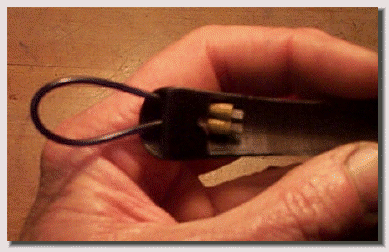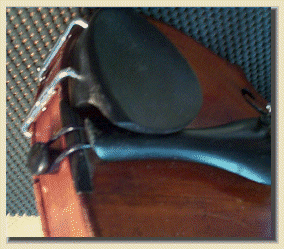...Remember that the new tailgut will stretch with string tension so make the tail gut a bit short to begin with. As a practical guide, adjust the tail gut length to near but not touching the saddle [the saddle is that ebony block of wood the tail gut sits upon]. Then under full string tension is will have just a little clearance back to the saddle. Approximately 1/8".
(modified 2/2022)
Page AA_05
Tail Piece Gut Adjustment for best performance....
... A short historical note might be in order here. The ' Gut' refers to the time when the trail piece gut {or attaching cord} really was made of sheep gut [made up of square leather strips from the middle lining of the small intestines]. Nowdays this is often made of a tough synthetic plastic, which usually has a threaded brass sleeve nuts for adjustment at each end



..Now for fine tuning, once the tail gut has finished stretching, perhaps a day or two, we want to adjust
the tailgut so that the distance of the string 'stop' ( that distance from just touching the ebony nut at the peg end of the fingerboard, to half the distance across the top of the bridge {both in the center of the D and A strings at the center line of the instrument}. This measurement will be approximately 13".
This should be done when the center of the bridge is centered on the inner sound hole notch on the right side of the instrument, and , with the back of the bridge vertical to the plate top at that location.
Now divide that measurement by 6. This is the desired length from the center of other center of the bridge to the center of the string bar on the tailpiece. Write down your current measurement.
Now we will adjust the screws under the tailpiece to lengthen or shorten the tail gut so that this is exactly (1/6) the 'stop' length for your instrument, as measured above.
Divide this by: 0.023" for English measurements and by 0.588 mm for metric. Write this down.
This is the number of turns you must turn the tail gut screws to move to the desired 1/6th dimension.
It really is important for best sound!
The tailgut threads are 44 threads per inch for the popular Sacconi tail guts.
I mark the brass threaded collars with a paint pencil line down their center and after carefully loosening the tuning pegs to release the strings from the tail piece; make this number of correcting turns equally to both screws. (in or out depending on whether you are too long or too short.
Reassemble, retune, and enjoy!






